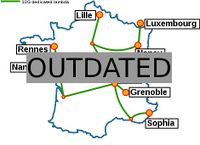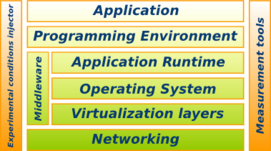Grid5000:Home: Difference between revisions
No edit summary |
No edit summary |
||
| Line 15: | Line 15: | ||
=== Journée Aramis === | === Journée Aramis === | ||
Le 16/04 aura lieu la journée Aramis "Usages et services du cloud dans notre environnement enseignement supérieur et recherche" avec une présentation de Grid'5000 par Simon | Le 16/04 aura lieu la journée Aramis "Usages et services du cloud dans notre environnement enseignement supérieur et recherche" avec une présentation de Grid'5000 par Simon Delamare. | ||
Cette journée est webcastée par la cellule Webcast du CC-IN2P3. Vous pouvez donc suivre en direct les [http://webcast.in2p3.fr/live/pleiniere_aramis_2014 présentations]. Le programme de la journée est disponible [http://aramis.resinfo.org/wiki/doku.php?id=pleniaires:pleniere17avril2014 ici] | Cette journée est webcastée par la cellule Webcast du CC-IN2P3. Vous pouvez donc suivre en direct les [http://webcast.in2p3.fr/live/pleiniere_aramis_2014 présentations]. Le programme de la journée est disponible [http://aramis.resinfo.org/wiki/doku.php?id=pleniaires:pleniere17avril2014 ici] | ||
Revision as of 16:13, 16 April 2014
|
|
Latest updates from Grid'5000 users
- Publications
Five random publications that benefited from Grid'5000 (at least 2786 overall):
- Alan Lira Nunes, Cristina Boeres, Lúcia Maria de A. Drummond, Laércio Lima Pilla. Optimal Time and Energy-Aware Client Selection Algorithms for Federated Learning on Heterogeneous Resources. 2024 IEEE 36th International Symposium on Computer Architecture and High Performance Computing (SBAC-PAD), Nov 2024, Hilo, France. pp.148-158, 10.1109/SBAC-PAD63648.2024.00021. hal-04690494v2 view on HAL pdf
- Rosa Pagano, Sophie Cerf, Bogdan Robu, Quentin Guilloteau, Raphaël Bleuse, et al.. Making Control in High Performance Computing for Overload Avoidance Adaptive in Time and Job Size. CCTA 2024 - 8th IEEE Conference on Control Technology and Applications, Aug 2024, Newcastle Upon Tyne, United Kingdom. pp.1-8. hal-04669743 view on HAL pdf
- Tristan Benoit, Jean-Yves Marion, Sébastien Bardin. Scalable program clone search through spectral analysis. ESEC/FSE '23 - 31st ACM Joint European Software Engineering Conference and Symposium on the Foundations of Software Engineering, Dec 2023, San Francisco, United States. 10.48550/arXiv.2210.13063. hal-03826726v4 view on HAL pdf
- Imran Ahamad Sheikh, Emmanuel Vincent, Irina Illina. Training RNN Language Models on Uncertain ASR Hypotheses in Limited Data Scenarios. Computer Speech and Language, 2024, 83, pp.101555. 10.1016/j.csl.2023.101555. hal-03327306v2 view on HAL pdf
- Donatien Schmitz, Guillaume Rosinosky, Etienne Rivière. Justin: Hybrid CPU/Memory Elastic Scaling for Distributed Stream Processing ⋆. DAIS 2025 - 25th International Conference on Distributed Applications and Interoperable Systems, Daniel Balouek; Ibéria Medeiros, Jun 2025, Lille, France. pp.1-17. hal-05081993 view on HAL pdf
Latest news
Journée Aramis
Le 16/04 aura lieu la journée Aramis "Usages et services du cloud dans notre environnement enseignement supérieur et recherche" avec une présentation de Grid'5000 par Simon Delamare.
Cette journée est webcastée par la cellule Webcast du CC-IN2P3. Vous pouvez donc suivre en direct les présentations. Le programme de la journée est disponible ici
Grid'5000 Charter revised
The Grid'5000 charter has been reworded and simplified so as to be more inclusive about possible uses. The rules to ensure availability during the day for any user and during the night for large resource usage have not been changed.
Grid'5000 school 2014 announced
Organized in Lyon, from June 16th to June 19th 2014, this spring school will bring together, but is not limited to, Grid'5000's users, technical team and executive committee for 4 days of tutorials and talks focusing on best-practices and results. Presentations and practical sessions will cover both basic usage of the platform, for new users, or potential users of Grid'5000 and advanced and new usage of the platform, for current users. Deadline to submit presentation proposals is March 29th, 2014.
Grid'5000 users win second prize at CCGRID 2013's SCALE challenge
Snooze based entry running on Grid'5000 entry wins 2nd prize at CCGrid 2013 SCALE challenge: well done Matthieu and Anne-Cécile for defending the entry titled Scalability of the Snooze Autonomic Cloud Management System by Eugen Feller, Christine Morin, Matthieu Simonin, Anne-Cécile Orgerie, and Yvon Jégou.
Grid'5000 users finalists of the SCALE'2013 challenge
Two submissions (out of five) from Grid'5000 users took part in the final of the international SCALE'2013 challenge (held with CCGrid'2013):
- D. Balouek, A. Lèbre, F. Quesnel Flauncher and DVMS -- Deploying and Scheduling Thousands of Virtual Machines on Hundreds of Nodes Distributed Geographically
- Eugen Feller, Christine Morin, Matthieu Simonin, Anne-Cécile Orgerie, and Yvon Jégou -- Scalability of the Snooze Autonomic Cloud Management System.
The first proposition presents the deployment and scheduling of thousands of virtual machines, conducted with the Flauncher and DVMS frameworks, across the Grid'5000 testbed. The frameworks have been able to deploy and schedule up to 10000 VMs during the tests. This research has been conducted in the context of the INRIA Hemera initiative.
The second proposition presents the Snooze architecture and focus on the following aspects :
- System set up scalability and resources consumption,
- Self-healing capabilities.
The deployment of Snooze were distributed over several sites of the Grid'5000 testbed. The framework has been able to start 11000 of system services, recover thousands of failures and used to launch large hadoop/mapreduce experiments. This research has been conducted in the context of the INRIA Snooze ADT.
Grid'5000 tutorial during ComPAS'2013
The ComPAS'2013 conference (replacing RenPar, SympA and CFSE), to be held in Grenoble between January 15th and 18th, will feature a Grid'5000 tutorial.
Grid'5000 at a glance
- Grid'5000 is a scientific instrument for the study of large scale parallel and distributed systems. It aims at providing a highly reconfigurable, controlable and monitorable experimental platform to its users. The initial aim (circa 2003) was to reach 5000 processors in the platform. It has been reframed at 5000 cores, and was reached during winter 2008-2009.
- The infrastructure of Grid'5000 is geographically distributed on different sites hosting the instrument, initially 9 sites in France (10 since 2011). Porto Alegre, Brazil is now officially becoming the first site abroad.
Sites:
- Grid'5000 is a research effort developing a large scale nation wide infrastructure for large scale parallel and distributed computing research.
- 19 laboratories are involved in France with the objective of providing the community a testbed allowing experiments in all the software layers between the network protocols up to the applications.
The current plans are to extend from the 9 initial sites each with 100 to a thousand PCs, connected by the RENATER Education and Research Network to a bigger platform including a few sites outside France not necessarily connected through a dedicated network connection. Sites in Brazil and Luxembourg should join shortly, and Reims has now joined.
All sites in France are connected to RENATER with a 10Gb/s link, except Reims, for the time linked through a 1Gb/s
This high collaborative research effort is funded by INRIA, CNRS, the Universities of all sites and some regional councils.
ALADDIN-G5K : ensuring the development of Grid'5000
For the 2008-2012 period, Engineers ensuring the development and day to day support of the infrastructure are mostly provided by INRIA, under the ADT ALADDIN-G5K initiative.
HEMERA: Demonstrating ambitious up-scaling techniques on Grid'5000
Héméra is an INRIA Large Wingspan project, started in 2010, that aims at demonstrating ambitious up-scaling techniques for large scale distributed computing by carrying out several dimensioning experiments on the Grid’5000 infrastructure, at animating the scientific community around Grid’5000 and at enlarging the Grid’5000 community by helping newcomers to make use of Grid’5000.
Initial Rationale
The foundations of Grid'5000 have emerged from a thorough analysis and numerous discussions about methodologies used for scientific research in the Grid domain. A report presents the rationale for Grid'5000.
In addition to theory, simulators and emulators, there is a strong need for large scale testbeds where real life experimental conditions hold. The size of Grid'5000, in terms of number of sites and number of processors per site, was established according to the scale of the experiments and the number of researchers involved in the project.
Current funding
As from June 2008, INRIA is the main contributor to Grid'5000 funding.
INRIA |
CNRS |
UniversitiesUniversity Joseph Fourier, Grenoble |
Regional councilsAquitaine |




